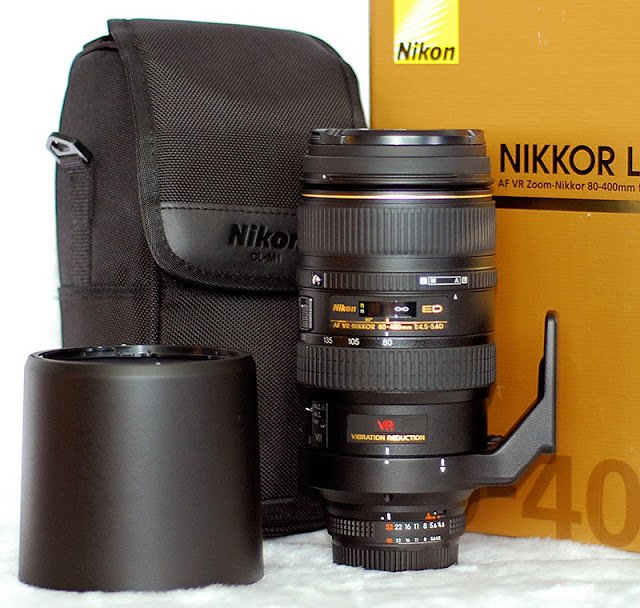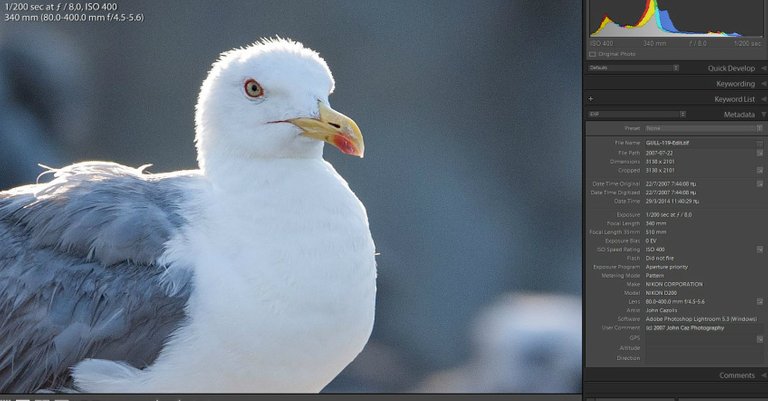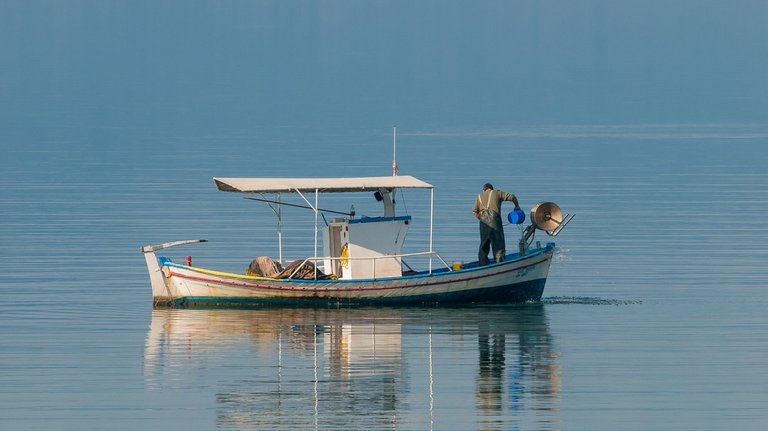NOTE: This article was first published over at johncaz.net on the 29th March 2014

INTRO
So you have done some research and found a lot of negative reports on the 80-400mm VR lens and are worried that they might be true. Some are saying that AF is sluggish with hints of hunting and at 400mm things get very soft! Are these true? Well, yes and no. To a certain degree some of it can be thrown at this lens when in anger or disappointment or when chart shooting, but in every day use, this lens can produce outstanding results if treated the right way and under the right circumstances as I will explain further down. But for those not familiar with this lens, let’s first have a closer look at its specifications and description.

QUICK SPECS
- It is comprised of 17 elements in 11 groups.
- It uses a 9-bladed diaphragm design with curved blades
- The front of the lens, which doesn’t rotate accepts 77mm filters.
- The AF mechanism is the old screwdriver type
- The close focusing capability is acceptable at 2.3m
- Thankfully, the tripod collar is removable
- The size is compact for such range at only 91mm x 170mm.
- And the weight is OK at 1,340g especially when compared to the heavier AFS 80-200mm.

FIRST IMPRESSIONS
This is a small and compact design, considering we are talking about a full frame 400mm lens. It is also light for such a complex design which comprises of 17 elements, so hand holding this "compact" long reach telephoto-zoom is not that painful, though I am of a large build, so I personally find no trouble carrying this lens when birding, though it will cause fatigue quite quickly especially when combined with a pro body which is recommended for balancing reasons and better AF performance. So it’s not big and heavy like most faster telephoto lenses (500mm f/4) but rather compact and light, similar to the AF 80-200mm f/2.8D. Another advantage of using such a long zoom on a DX format camera, is that the angle of view becomes equivalent to a 120-600mm focal length; Now that's one powerful package!

OPTICAL PERFORMANCE
On the subject of sharpness I have a warning to pass along. If you are not getting sharp results from this lens, one reason may be because your shutter speeds are too low and another may be wrong focusing (discussed further down in the autofocusing section). I tend to close 2/3 of a stop if the light permits or even zoom back a little from 400mm to say 380mm if the subject is large enough in the frame, not because my results otherwise would be soft or bad, but because they will help to gain a little more sharpness and contrast.
80-300mm range: Between 80mm and 300mm this lens can produce very good results similar to but not better than the AFS 70-300mm VR, so if you are interested in this range, the much cheaper 70-300mm VR is the better choice. But most people will most probably be investing in the 80-400mm for its long reach.
400mm: At the long end, this zoom can deliver sharp results though at times it also seems to deliver some softness. This is because the area of softness surrounding the sharp center is quite large. So wide open its very sharp in the center with softer edges. Closing down a little to f/7.1 improves the sharpness and contrast while extending those characteristics over a much larger portion of the frame. At f/8 performance is excellent all over and at f/11 performance peaks. From there onwards, performance degrades fast and most probably should be avoided. The AF 80-400mm VR in most cases produces excellent results but it excels at shooting static subjects that are well lit and are close to the lens.
Ghosting and flaring: Shooting against the sun or other bright light sources seem to have little negative effect on this zoom. I don’t think you can find many zooms that would let you shoot against the sun with such performance. If you are getting flare with your copy, I would suggest you clean your lens and remove any unnecessary filters from the front of it.
Bokeh: Although complex designs such as this 17-element zoom don’t help in the bokeh department, the OOF (out-of-focus) areas of this zoom are too horrible and highlights are pleasant thanks in part to its incorporation of a rounded 9-bladed diaphragm. Overall, nothing special.
Distortion: Distortion is usually a problem with wide angle lenses or for photographers shooting architecture, so I don’t think anyone considering this lens should worry about distortion.
Vignetting: On the subject of vignetting, the 80-400mm is surprisingly good when compared to my old AF 80-200mm f/2.8D lens which had noticeable light fall off toward the edges of the frame wide open and at f4. And this observation is based on the results from a full frame camera, so on a DX format camera the vignetting is a non-issue.
Chromatic aberrations: At 400mm and on most DX format cameras some chromatic aberrations (usually purple fringing) are present but can be easily removed by Adobe Lightroom by selecting the "Remove Chromatic Aberration" option under the "Lens Correction" tab. Other software can remove this automatically also.

Nikon D200 & AF-D 80-400mm Exposure: 1/350sec @ f/8 ISO 400
VR TECHNOLOGY
You shouldn't think of VR as a way to shoot at ridiculously slow shutter speeds. The VR technology is for helping to stabilize natural camera movement under normal shooting conditions. Unfortunately, long reach and light weight don't go too well together. The lighter you make a long lens, the easier it is to introduce blurry or soft images due to human movement or micro vibrations from the camera even at fast shutter speeds. To help improve your success rate with this lens, try to use the highest acceptable ISO setting and aim for high shutter speeds and good quantity of light.
The VR technology is of little help for moving wildlife, though a welcome addition, especially for those trekking or traveling. The best way to get the most out of this lens is to forget about its VR capabilities. You are shooting at 400mm (600mm on DX) and so should be trying to maximize your yield by aiming for the highest shutter speeds possible. Let VR work in the background, and it will do its part. Some inexperienced photographers, buy this lens and expect to be shooting birds handheld with shutter speeds of 1/60 sec. - forget it!

With this lens, there is no need to switch from one of the AF modes to MF on the body. To quickly change from AF to MF and back again you can use the updated Auto/Manual focus mode ring on the lens which quite surprisingly worked better than I originally thought. It can be moved quite easily (once you get used to it) with the hand supporting the camera and there is no need to lock the selection unless you want to. It’s no comparison to the AFS solutions, but at least you have that option, even though it’s a dated design.
As we have already seen, the optics that needs to be moved for AF are heavy and that’s one of the reasons of its slow AF performance. The same issue applies to zooming, which also requires the movement of a lot of glass, so it requires some muscle to turn the zoom ring which can be frightening at first if you are used to a small zoom like the AFS 24-120mm.
Best way to get sharp results
If you want sharp results, you need to “continue” using long lens techniques, support yourself and camera as much as possible, aim for the highest speeds and just let the VR technology do its thing. This lens requires that you shoot 5-6 frames in succession so you can pick the best result. Some are usually blurred looking mostly due to micro vibrations, but then in the series you will find one or two that really pop. I sometimes fire off 5-6 frames and then refocus and shoot again (EDIT: This was before AF fine tune was available). Although I have some very sharp results at some insanely slow shutter speeds (eg: 1/60 @ 400mm with VR), I usually try to stick with speeds of 1/500sec or faster on a DX format camera. With a DX body the old rule of thumb says that a shutter close to 1/600sec is needed to get a chance at sharp results. Thankfully, most of the times, I end up with plenty of sharp results to choose from.
AUTOFOCUSING
Two negative characteristics of the AF 80-400mm VR are its AF speed and AF acquisition. These are the biggest negative points of this lens though they can be overcome with a little finesse. The lens reminds me of my beloved AF 80-200mm which was also a slow focusing lens. Not only are they both screwdriver type lenses, but the amount of travel that the mechanism has to traverse compared to other lenses, is of a quadruple measure. Nikon is forced to use low gearing so as to be able to move the heavy optics involved in this design. And having a slow aperture of f/5.6 @ 400mm doesn’t help much either when it comes to focusing accurately. When you read the various post about softness, most of them really are referring to out-of-focus results which they interpret as un-sharp. You need to secure a well focused subject before you can comment on sharpness. Sometimes, I will even resort to manual focusing. There are ways to improve its AF capabilities. One is to pre-focus so the AF will have less distance to travel and another is to use the focus range limiter switch. The limiting range is from 2.3m to just under 4 and then from 5 to infinity - surely not practical and I don't know why Nikon chose that range. I would have preferred an overlap such as 2.3m to 10m and say from 7m to infinity. Anyway, another way to improve AF, is with the use of a pro body such as the D3. Pro-calibre cameras offer greater torque from their AF motors compared to their smaller brothers so the autofocusing on the pro cameras can be expected to perform faster and more accurately.

From this 10 frame series, all were useable. But only the last 3 were really sharp. This series doesn’t prove that this lens is good for sports. Its not! But it can under certain circumstances do action when needed. If you want a sports/action lens, look elsewhere.
VR IN ACTION
The AF 80-400mm VR lens is a hard lens to describe because it is a hard lens to “learn” and “tame”. The image below of the seagull is an incredible shot if you consider the shooting conditions; I was standing in a moving boat in choppy water. As you can see, I was also shooting against the light with the zoom extended to 340mm, which is equivalent to a focal length of 510mm on the DX format. Taking all those factors into consideration, one can see how well the VR has performed utilizing a slow shutter of only 1/200 sec. Now that, to my eyes is an incredible performance.

Beware though, that this is not repeatable performance. The AF 80-400mm VR can not repeat this kind of performance all the time. It definitely is capable of it, as long as the photographer has come to terms with its shortcomings and has managed to tame it. On a side note, I would like to add, that most of the shots that I like from this lens are shot at f/7.1 or f/8. I have images at f/5.6 also and they are pretty good, but obviously, closing the aperture a bit does improve sharpness and contrast as does reducing the focal length.
MACRO ACCESSORY
One accessory that can complement this lens (and the AFS 300mm f/4 as well), is the Canon close-up 500D filter. This looks like a regular screw on filter, but is of a high quality two lens design that helps to reduce the minimum focus distance. Although the lens can shoot some remarkable close-ups, with the addition of the 500D, those butterflies really jump of the page.
LAST WORDS
So the AF 80-400mm VR is not the sports action lens nor the super sharp tele you were hoping it to be, but a very good travel or nature trekking lens. Unfortunately, 400mm doesn't come cheap, at least from Nikon. But for the money you get a chance at some excellent images under certain conditions as already described. If you are not happy with your results, remember to use the fastest shutter speeds possible and double-check the focusing accuracy. The important thing to remember is that this lens can deliver some excellent results, though it may require extra work from the photographer and some extra light as well.
IMAGES TAKEN WITH THE AF 80-400MM F/4.5-5.6D VR







UPVOTE & SHARE
If you enjoyed this article I would really appreciate an upvote ;-) You could also help me by resteeming my article for others to find and read, thanks!
Hi! I am a robot. I just upvoted you! I found similar content that readers might be interested in:
http://www.johncaz.net/blog/af-80-400mm-f45-56d-ed-vr
Congratulations @johncaz! You have completed some achievement on Steemit and have been rewarded with new badge(s) :
Click on any badge to view your own Board of Honor on SteemitBoard.
For more information about SteemitBoard, click here
If you no longer want to receive notifications, reply to this comment with the word
STOPCongratulations @johncaz! You have completed some achievement on Steemit and have been rewarded with new badge(s) :
Click on any badge to view your own Board of Honor on SteemitBoard.
For more information about SteemitBoard, click here
If you no longer want to receive notifications, reply to this comment with the word
STOP